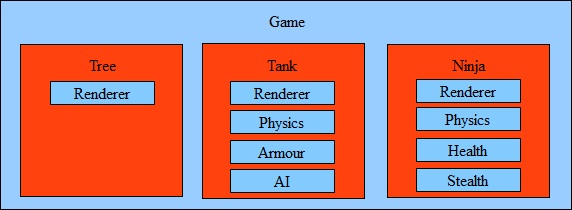“Favour composition over inheritance”
If you haven’t already read my previous post on the problems of traditional game architecture and why entity systems are needed. I’m going to cover the basics of an entity system before we look at 3 different implantations and the pro’s and con’s of each.
What is an entity?
An entity (sometimes called game object) represents something in the game. For every tree,tank or ninja we have an entity. An entity is container to which we can add components (behaviours) that define what it is. e.g In this rather conceptual example a Ninja gets a Renderer, Physics, Health and Stealth components which together make up a Ninja.
This is the basics of all Entity systems one of key feature is the ability to create entities and change there components at run time. So a Ninja could become a Tank! (that’s the hard sell done).
Spotter guide.
There are 3 main ways to implement an entity system I have seen and I’m going to quickly out line them all and take a critical look at the pro’s and con’s. I’m going to call them common, almost and true (yes I’m bias but I think they are appropriate names)
“Common”
Most common implantation you are going to come across. Its based on the strategy pattern and its the simplest to understand. The first time I built a entity system this is what I did. There are good example out there in flash like PushButton Engine.
How it works
All components have a common interface normal with a function update(). Calling update() on entity causes update() to be called on all its components. Components then update there data for example a render component may copy its graphics to a view port.
Pros
Simple and fast. Better than inheritance.
Cons
Scalability and flexibility (how easy it is to make changes). To explain the issue lets take an example. We have an entity with both renderer and physics components. Both need to know about the location of the entity in the world. So we have two options
- push the data up into the entity its self. In complex games this can result inmore and more specialised data gets pushed up into the entity creating a god object.
- Allow components to access other components data. When one component depends on the data in another component we get a dependency. Component A can’t function unless component B exists. As a game grows so does the complexity of the dependencies.
There are work arounds to this issue for example automatically creating component B when A is added but then we need to give it the correct data. We start to lose the ability to mix and match components on the fly that makes an entity system so powerful. Entity to entity communication for example in collision detection is also difficult.
“Almost”
[...]


No comments:
Post a Comment